Climate Illuminated

Outlook on Energy Until 2040

WUWT Article Link / 2 weeks ago
ExxonMobil released its 2017 Outlook for Energy, A View to 2040 in mid-December. David Middleton has written that the report reveals wind and solar will supply a whopping 4% of global energy by 2040! He also reports that wind and solar capacity will grow, but we will only be able to utilize 30% of the wind capacity and 20% of the solar capacity due to their intermittent nature. This is true, but the report has much more to say and this year the nomination of ExxonMobil CEO Rex Tillerson for Secretary of State makes it even more important. Here we will cover some the other numbers in the report.
The cost of energy is closely correlated to standard of living. In addition, it has often influenced major political decisions, like Germany’s decision to invade Russia or Japan’s decision to bomb Pearl Harbor in World War II. Figure 1 shows the relationship between per capita GDP (one standard measure of standard of living) and annual per capita electricity consumption for 218 countries in the CIA Factbook.
Excluding the anomalous countries listed in the upper right of the figure the R2 is acceptable. The least squares line suggests that each 0.2 kWhr/person of electricity consumed annually can raise GDP by one dollar per person. Obviously, other factors are important also, but the trend suggests that per capita GDP is positively influenced by the electricity consumed or that countries with a higher standard of living use more electricity.

Figure 1
If all 218 countries are included the R2 falls to 0.49, but the slope is nearly the same at 0.208. Energy consumed is undoubtedly partially a function of the cost of energy as long as the basic infrastructure for delivering electricity is in place. I could only find consistent data for the cost of electricity in purchase power parity dollars (PPP$) for eleven countries with good electricity infrastructure.
They are plotted in Figure 2. Data was also available for China, Mexico, Brazil, India and Nigeria, but it was not used because the electricity delivery infrastructure did not cover enough of the population. Purchase Power Parity dollars were used because a US dollar will buy a different amount of goods in different countries. Food, housing and gasoline, for example, cost more in Europe (in US $) than they do in the USA. So, plotting the cost of electricity versus actual price, converted to US dollars would be very misleading. F or more information on Purchase Power Parity see here.
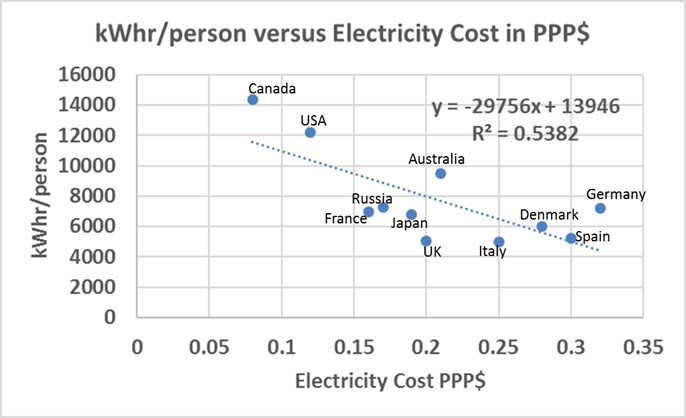
Figure 2

Figure 3 (Source ExxonMobil)
Figure 3 shows total energy use per person compared to the 2014 UN Human Development Index for countries around the world. It shows the same positive relationship between standard of living and energy use. Because standard of living and energy use are closely related and energy use is strongly affected by the cost of energy, it is in the best interest of any country to lower the cost of energy and make it readily available. Therefore, you can be sure that some of the decisions made by President Trump and Secretary Tillerson will be based, at least in part, upon the ExxonMobil data and their projections.
Developing countries, like China and India are urbanizing and their populations are becoming more affluent, this will increase global energy demand 24% by 2040. This includes the ExxonMobil prediction that energy use efficiency will double (figure 4). The world population will increase from 7.3 billion today to over 9 billion in 2040, with a much larger middle class population (defined as >$14,600 and <$29,200 yearly/a> for a family of 4) using energy than today.
World GDP will effectively double by 2040. Living standards will rise dramatically, especially in the developing world. Natural gas consumption will increase 54 quadrillion BTUs by 2040. Nuclear and renewables will increase 24 and 20 quadrillion BTUs, respectively. The 2040 energy mix will remain about the same as today (figure 5 and Table 1). Rising electricity demand will drive the growth in global energy between now and 2040. The increase in the number of homes with electricity, industrialization of the developing world and our increasingly digital and plugged-in lifestyles will drive this growth. Half of global electricity demand is from industrial activity; thus good jobs can be lost if electricity costs are too high.
Jobs will move to locations where electricity is cheap, an example is the new Voestalpine steel plant in Corpus Christi, Texas. Crude oil and natural gas will remain the world’s primary energy source. Even in 2040 oil and natural gas will supply 57% of all energy demand, this is an increase from 56% today. Oil demand will grow 18% through 2040 and natural gas demand will grow 44%. The developing world will account for the largest increases. Unconventional (“fracked”) oil and gas, oil (“tar”) sands, and deep water oil production will account for over 25% of the liquid supply in 2040. Carbon dioxide emissions will increase, at least until 2030.
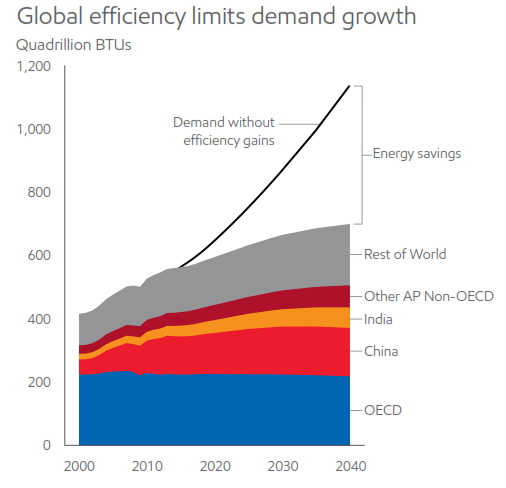
Figure 4 (Source ExxonMobil)

Figure 5 (source ExxonMobil)
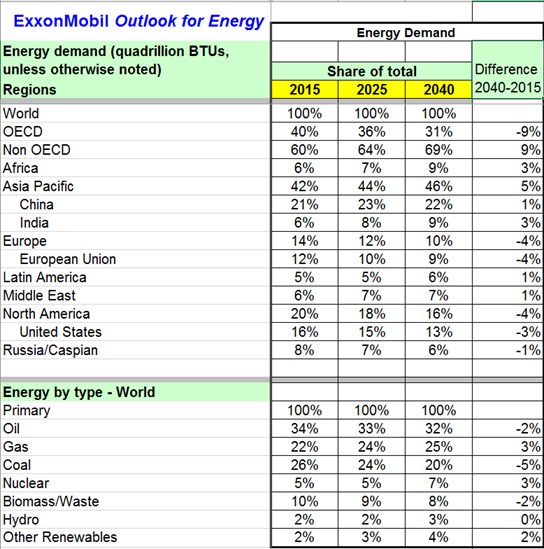
While the population will be much higher and more affluent in 2040, there will be gains in energy efficiency due to new technology. Efficiency gains restrain energy demand growth in developed countries, but the demand in the developing world rises dramatically due to the rapid growth of the world middle class. The global middle class is expected to double in size (see figure 7) in the next 15 years and many of the newly middle class will be first time users of electricity and petroleum. Nearly everyone in the developed world is already in the middle or upper class and already uses energy. The dramatic growth in energy use in the developing world, relative to the developed world, is shown in figure 6.
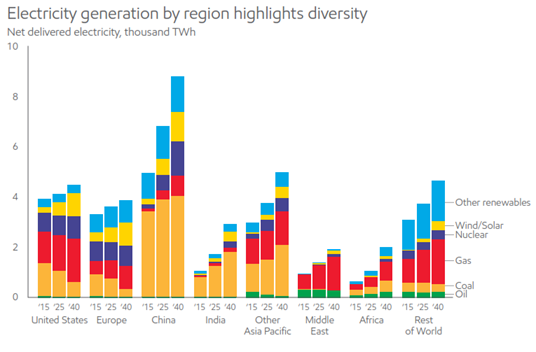
Figure 6 (source: ExxonMobil)
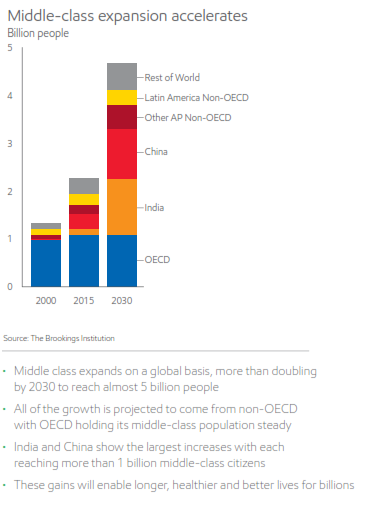
Figure 7 (source: ExxonMobil)
Coal demand is expected to rise slightly until 2025 and then fall back to current levels by 2040 almost entirely due to new coal fired power plants in the developing world. The global fleet of cars, SUV’s and pickups will grow 80% to roughly 1.8 billion vehicles. Gasoline and diesel will dominate as a vehicle fuel, but there will be some growth in electric and hybrid vehicles, see figure 8.
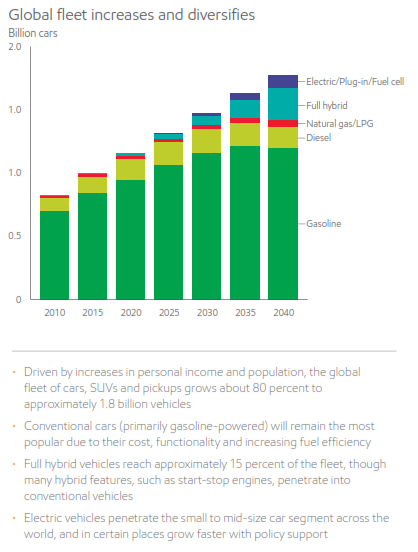
Figure 8 (source: ExxonMobil)
One can debate whether reducing carbon dioxide emissions is important or not, but if we assume we need to reduce carbon dioxide, it seems clear that producing shale gas and using it to produce electricity is more effective than using wind or solar. This is made clear by comparing the change in carbon dioxide emissions in the United States with those in Germany. ExxonMobil produced Figure 9 to illustrate the point.
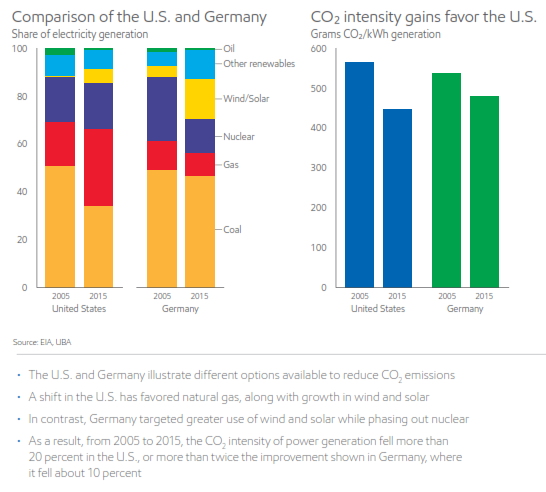
Figure 9 (source: ExxonMobil)
The growth of North American unconventional (“fracked”) natural gas production is critical as can be seen by comparing projected demand (horizontal black lines) to supply around the world as ExxonMobil does in figure 10.
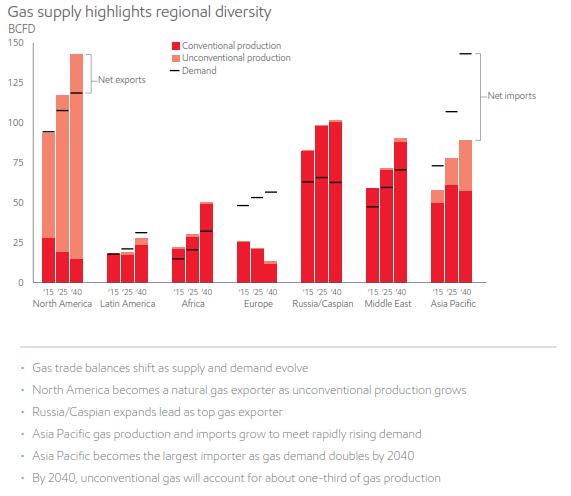
Figure 10 (source: ExxonMobil)
The media loves to report things like “solar energy will double” or “solar and wind are growing faster than fossil fuels.” While true, these statements are misleading because little of our energy comes from these sources, so doubling them makes no significant difference. This report supplies ExxonMobil’s best assessment of where we are and where we are likely going with respect to energy. I doubt their predictions are perfect, but I would wager they are close. The main takeaway is there is not going to be a major change in our energy infrastructure or energy supply mix over the next 25 years. It is possible that growth in carbon dioxide emissions will slow, but it is inevitable that emissions will be higher in 2040 than they are today.
It is also clear that we are not going to run out of coal, oil and natural gas. These are abundant today and they will still be abundant in 2040. Given the very high quality of available modern emissions control equipment for true pollutants, like sulfur dioxide and mercury, and recent low estimates of equilibrium climate sensitivity to a doubling of carbon dioxide (ECS) there is little evidence that fossil fuels are a problem today or in the foreseeable future.
For a discussion of modern coal power plant emissions control equipment and its effectiveness see this report by Moretti and Jones of the Babcock and Wilcox Power Generation group or this EPA summary. All too often people seem to think that coal plants in China are equivalent to coal plants in the US or Europe. Modern very effective pollution control equipment has been in universal use in the USA and Europe for decades. As you can see in the reports, this equipment reduces noxious gases, like sulfur dioxide or nitrous oxide by 90%+. Unfortunately, this equipment has not been universally installed in China or elsewhere in the developing world, and that is one of the reasons that their air pollution is so awful. The other reason is some people in China (and elsewhere) still burn coal, wood and dung in their homes for cooking or heat and the emissions go straight into the air with no scrubbing at all. Some consider carbon dioxide a pollutant, but this is difficult to support given that it is essential for life on Earth.
All of the data used in making the figures in this post is available for download, as an Excel spreadsheet, here. The author, now retired, worked for Exxon from 1979 until 1985, he also owns stock in the company.
We should revisit occasionally what the proper role of government is. As the constitution was a good sense of direction, we need a core set of principles to add in order to deal with the future.
So many want to engineer society, remove risk, assist certain groups, rather than let individuals thrive and raise communities. Why?
Is Democracy where we all "get it good and hard" or is it the best means to a free society?
Should we roll with the special interests, or make the government achieve its proper role, what is that role, and how to do this?
When do deficits and governments become too large?
Government is becoming more elitist while trying to sell corrections to problems it created, what makes this possible?
This could also be inserted into the field above, or erased
Currently as a society, we are having a most difficult time discussing political issues. What is driving this? And why a rebirth in political culture would be a good thing.
Are "markets" dead as some would conjecture? Or is free enterprise what got us here?
At the heart of economics there are several possible economic schools of thought, the essence of these schools of thought and how they relate to our lives.